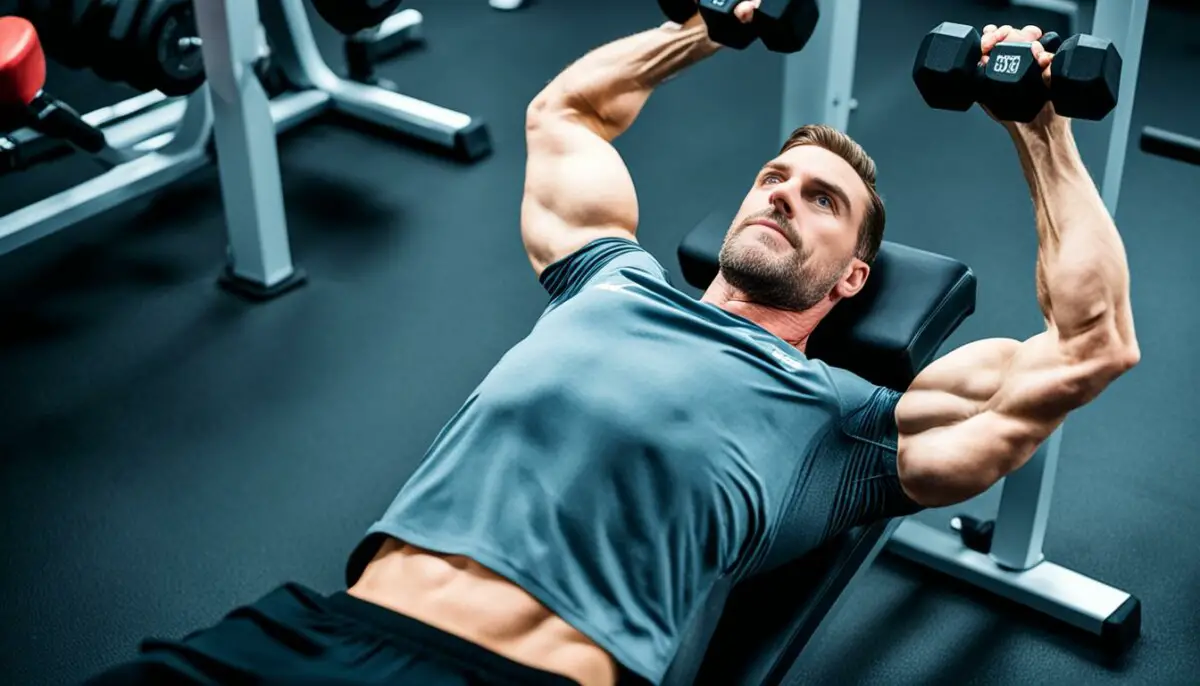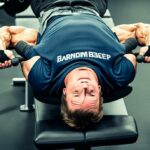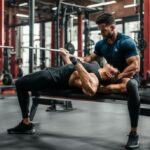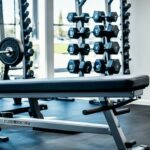Last Updated on 3 months by Francis
The dumbbell pullover is a versatile exercise that targets multiple muscles in the upper body. While it is commonly used by bodybuilders to work the chest and back muscles, it can benefit anyone looking to improve strength and flexibility in their upper body.
Contents
Key Takeaways:
- Dumbbell pullovers target multiple muscles in the upper body.
- They are effective for strengthening the chest, back, and other muscle groups.
- Pullovers can improve upper body strength and flexibility.
- The exercise can be adapted to target specific muscle groups based on arm and elbow orientation.
- Proper form and technique are important for maximizing the benefits of pullovers.
Benefits of Dumbbell Pullovers
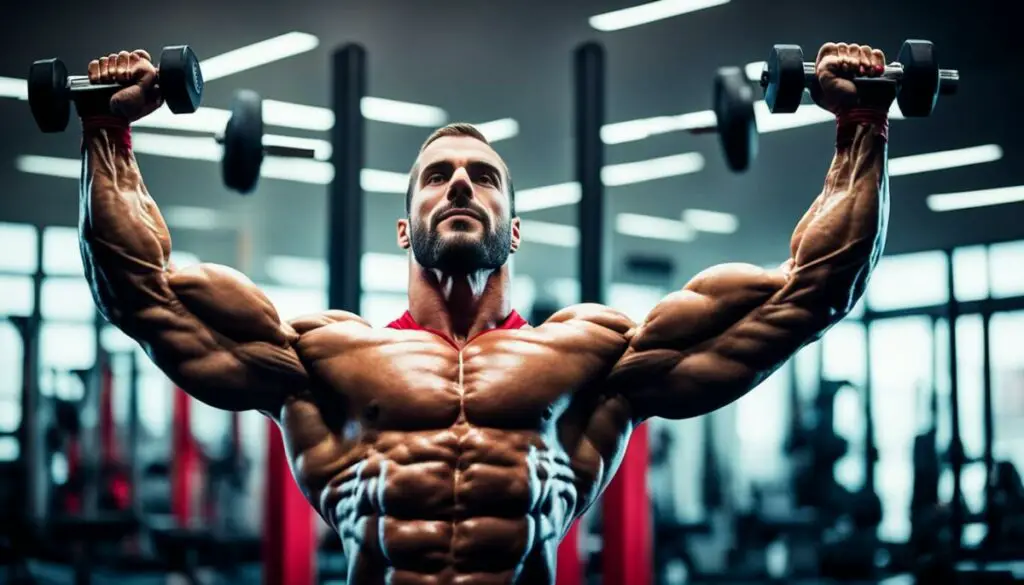
Dumbbell pullovers offer several benefits that can enhance your workout routine and contribute to your overall fitness goals.
- Improved Cardiopulmonary Function: Dumbbell pullovers elevate your heart rate, making them a great exercise to get your cardiovascular system pumping. The combination of upper body movement and controlled breathing can help improve endurance and strengthen your heart and lungs.
- Effective Upper Body Workout: Dumbbell pullovers engage multiple muscle groups in the upper body, making them a versatile and efficient exercise. The chest, back, shoulders, and triceps are primary targets, but the exercise can also engage the abdominal muscles and wrist flexors, providing a comprehensive upper body workout.
- Adaptable to Target Different Muscles: The orientation of the arm bone and the direction of the elbows during dumbbell pullovers can be adjusted to emphasize specific muscle groups. By experimenting with different angles and variations, you can target various muscles to achieve your desired results.
- Easily Accessible Equipment: Dumbbells, the main equipment used for pullovers, are readily available in most gyms and fitness centers. They come in different sizes and weights, allowing you to customize the intensity of your workout based on your fitness level and goals.
Adding dumbbell pullovers to your workout routine can maximize your upper body strength and enhance your overall fitness. Whether you’re a beginner or an experienced lifter, the benefits of pullovers make them a valuable addition to any exercise program.
Quote:
“Dumbbell pullovers are a fantastic exercise that targets multiple muscle groups in the upper body. They provide a great burn and can be adapted to suit different fitness levels and goals.” – Emily Smith, Certified Personal Trainer
To visualize the benefits of dumbbell pullovers, take a look at the following table:
| Benefits | Description |
|---|---|
| Improved Cardiopulmonary Function | Elevates heart rate and enhances cardiovascular endurance |
| Effective Upper Body Workout | Engages multiple muscle groups for strength and definition |
| Target Different Muscles | Can be adjusted to emphasize specific muscle groups |
| Easily Accessible Equipment | Dumbbells are readily available in most gyms and fitness centers |
Muscles Targeted by Dumbbell Pullovers
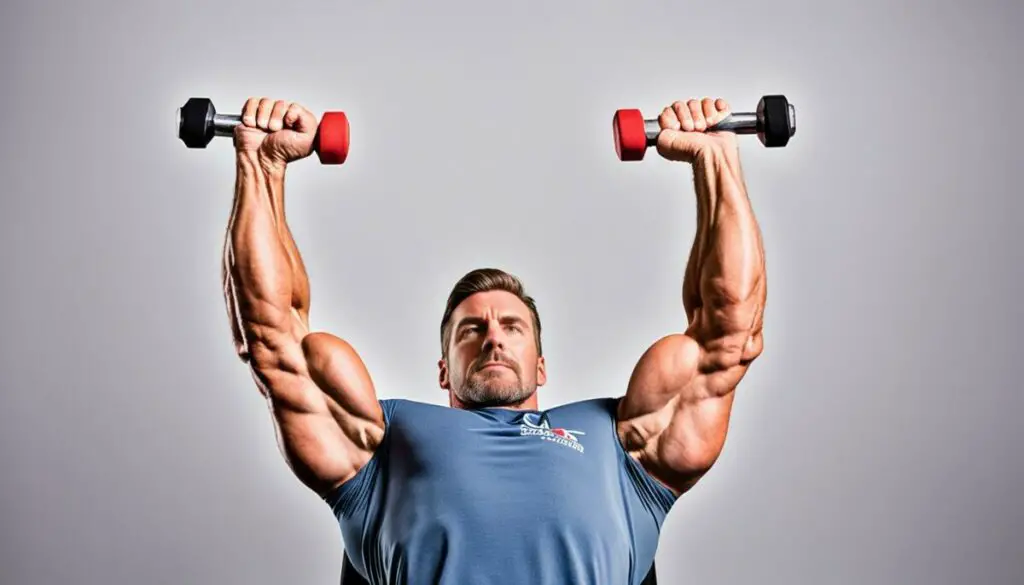
Dumbbell pullovers are a versatile exercise that targets multiple muscles in the upper body. The primary muscle group worked during pullovers is the chest muscles known as the pectoralis major. This exercise effectively engages and strengthens the chest muscles, contributing to a well-defined and sculpted chest.
In addition to the chest muscles, dumbbell pullovers also engage the back muscles called the latissimus dorsi. These muscles play a crucial role in pulling movements, and by incorporating pullovers into your workout routine, you can enhance back strength and achieve a balanced upper body.
Furthermore, pullovers engage the triceps, which are the muscles located at the back of the upper arm. The triceps are essential for arm extension and play a supportive role during pullover exercises.
The anterior deltoids, located at the front of the shoulders, are also activated during pullovers. These muscles assist in shoulder flexion and contribute to the overall movement and stability of the exercise.
Lastly, the wrist flexors are engaged during dumbbell pullovers, adding an element of grip strength to the exercise. The wrist flexors are responsible for flexing the wrists and play a role in maintaining proper form and control throughout the movement.
It’s worth noting that the abdominal muscles can be indirectly engaged during dumbbell pullovers when proper technique and core engagement are maintained. This additional activation can provide a comprehensive workout for the upper body, targeting multiple muscle groups simultaneously.
With the combination of targeted muscle engagement, you can see how dumbbell pullovers offer a comprehensive upper body workout, helping you develop strength, improve muscle definition, and enhance overall fitness.
How to Perform Dumbbell Pullovers with Proper Form
Proper form is essential when performing dumbbell pullovers to maximize the effectiveness of the exercise and prevent injuries. Follow these steps to ensure you are doing pullovers correctly:
- Start by selecting an appropriate weight dumbbell that challenges you but allows you to maintain proper form throughout the exercise.
- Find a flat weight bench and recline on it, ensuring your head and upper back are supported.
- Hold the dumbbell with both hands, extending your arms straight over your chest.
- Keep your feet flat on the floor or bench, creating a stable base.
- Maintain a neutral position in your pelvis and lower back, avoiding excessive arching or rounding.
- Breathe in as you lower the dumbbell back overhead, aiming for a full range of motion. Allow your shoulders to stretch and your chest to open up.
- Breathe out as you bring the dumbbell back to the starting position, engaging your chest and back muscles.
- Aim to perform 8-10 repetitions per set, focusing on controlled and deliberate movements.
- Complete 2-3 sets of dumbbell pullovers, with rest periods in between, to effectively stimulate the targeted muscles.
Remember to listen to your body and adjust the weight and range of motion according to your fitness level and comfort. It’s better to start with lighter weights and gradually increase as you gain strength and confidence in the exercise. Proper technique and consistency are key to reaping the benefits of dumbbell pullovers.
“Maintaining proper form while performing dumbbell pullovers is crucial for targeting the desired muscles and avoiding unnecessary strain or injury. Focus on the mind-muscle connection and perform the exercise with control and intention to get the most out of your workout.”
Check out the image below for a visual reference on how to perform dumbbell pullovers with proper form:
Variations of Dumbbell Pullovers
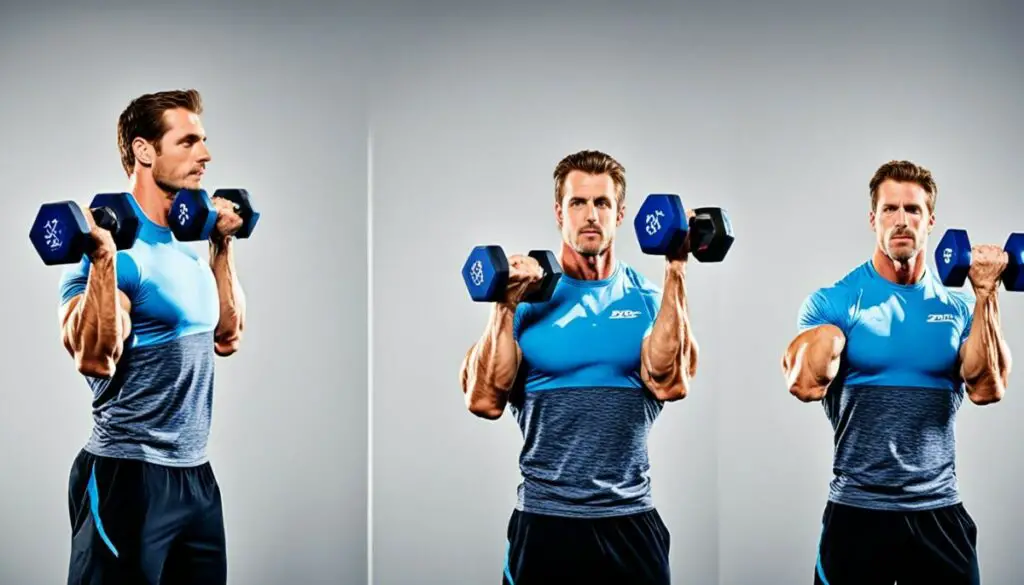
Looking to spice up your pullover exercises? There are several variations of the dumbbell pullover exercise that can add variety and target different muscle groups. Here are some options to consider:
Lying on the floor
Instead of using a bench, try lying on the floor. This variation can provide a different challenge and engage the muscles in a unique way.
Range of motion limitations
If you’re a beginner or have limited mobility, you can limit the range of motion during the exercise. This allows you to focus on proper form and gradually increase the intensity as you progress.
Glutes and core focus
For an added challenge to your glutes and core, change your body orientation. By lifting your hips off the floor or bench and maintaining a bridge position, you’ll engage these muscle groups while performing the pullover.
Alternative equipment
Instead of using dumbbells, you can try using a medicine ball or a barbell to perform the pullover exercise. These variations add a different level of difficulty and can switch up your routine.
Stability ball substitution
If you don’t have a bench, you can use a stability ball instead. This variation adds an element of instability, engaging your core muscles even more.
Decline bench challenge
Looking for an extra challenge? Try performing the dumbbell pullovers on a decline bench. This variation increases the difficulty level, providing a more intense workout for your upper body.
By incorporating these variations into your pullover exercises, you can keep your workouts interesting and target different muscle groups. Remember to start with lighter weights and gradually increase the intensity as you become comfortable with each variation. Push yourself, but always listen to your body to prevent injury.
Benefits of Dumbbell Pullovers for Upper Body Strength
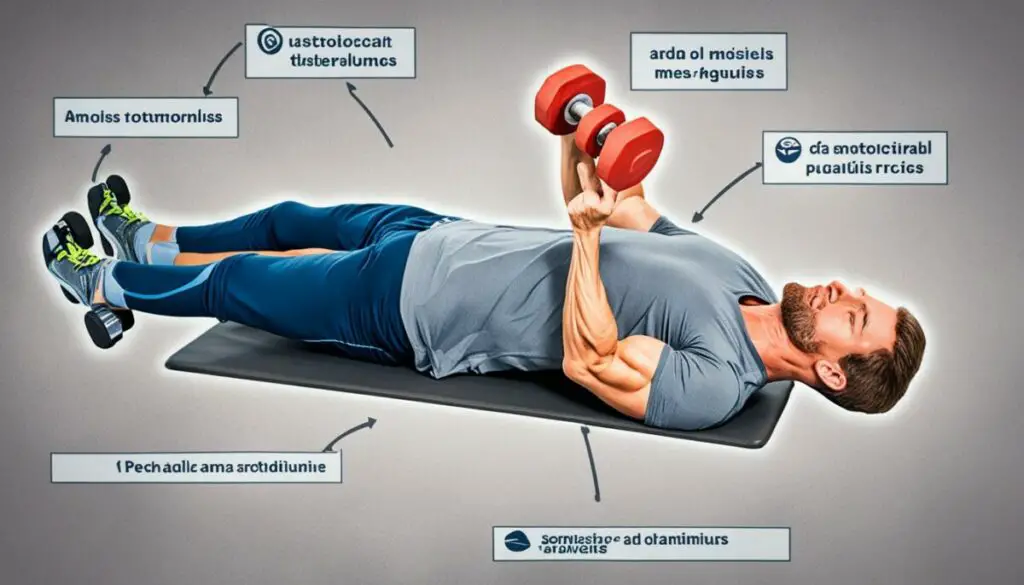
Dumbbell pullovers are highly effective for developing upper body strength. When performed with proper form, these exercises target the chest and back muscles, leading to increased muscle mass and strength in these areas. Incorporating pullovers into your workout routine can help you achieve a well-defined and strong upper body.
The primary muscles engaged during dumbbell pullovers are the pectoralis major (chest) and the latissimus dorsi (back). These muscles work together to move the weight and provide stability and support during the exercise. Additionally, other muscles such as the triceps, anterior deltoids, and wrist flexors also contribute to the movement to varying degrees.
To get the most out of your pullover workout, it’s essential to maintain proper form and technique. Choose an appropriate weight that challenges you without compromising your form. Focus on engaging the targeted muscles throughout the exercise, and breathe deeply to oxygenate your muscles.
Benefits of Dumbbell Pullovers for Upper Body Strength:
- Target the chest and back muscles for increased muscle mass and strength
- Engage the triceps, anterior deltoids, and wrist flexors to varying degrees
- Provide stability and support for the upper body
“Incorporating dumbbell pullovers into your workout routine can help you achieve a well-defined and strong upper body.”
Remember to start with lighter weights and gradually increase the intensity as your muscles become stronger. Always listen to your body and stop if you experience any pain or discomfort. Consult with a professional trainer or fitness expert to ensure proper technique and form.
| Benefits | Muscles Targeted |
|---|---|
| Increased muscle mass and strength | Chest (pectoralis major) and back (latissimus dorsi) |
| Improved upper body stability | Triceps, anterior deltoids, and wrist flexors |
Benefits of Dumbbell Pullovers for Flexibility
When it comes to improving flexibility and range of motion, dumbbell pullovers are an excellent exercise option. This particular movement pattern involves extending the arms overhead, which effectively stretches and opens up the shoulder and chest muscles. By incorporating pullovers into your fitness routine, you can counteract the tightening and rounding of the shoulders that often occurs from prolonged sitting or working at a desk.
The stretching and lengthening effect of the pullover exercise can help to improve the mobility and flexibility of the shoulders and chest. As a result, you may experience increased ease of movement in daily activities, such as reaching overhead or performing tasks that require a wide range of motion. Additionally, enhanced flexibility in these areas can also contribute to improved posture and reduced risk of muscle imbalances or injuries.
By regularly incorporating dumbbell pullovers into your workout routine, you can reap the benefits of increased flexibility and range of motion. Not only will it help you move more comfortably throughout your daily life, but it can also complement other exercises or sports that rely on upper body mobility. So, if you’re looking to enhance your flexibility and achieve a greater range of motion, consider adding dumbbell pullovers to your fitness regimen.
Incorporate the following tips to optimize your dumbbell pullover workout:
- Start with a weight that allows you to perform the exercise with proper form and control.
- Maintain a stable core and neutral spine throughout the movement.
- Focus on deep breathing to enhance relaxation and muscle lengthening.
- Perform the exercise in a slow and controlled manner, aiming for a full range of motion.
- Listen to your body and adjust the weight or range of motion as needed to prevent strain or discomfort.
Muscles Engaged in Dumbbell Pullovers
| Muscle Group | Primary Muscles Engaged | Secondary Muscles Engaged |
|---|---|---|
| Chest | Pectoralis Major | Anterior Deltoids, Triceps |
| Back | Latissimus Dorsi | Posterior Deltoids, Rhomboids, Biceps |
| Shoulders | Anterior and Medial Deltoids | Triceps, Upper Trapezius |
Tips for Performing Dumbbell Pullovers Safely and Effectively
Performing dumbbell pullovers with proper form and technique is essential to ensure safety and maximize the effectiveness of the exercise. By following these tips, you can get the most out of your pullover workout:
- Choose an appropriate weight: Select a dumbbell weight that challenges you without compromising your form. Start with lighter weights and gradually increase as you become more comfortable and confident.
- Maintain stability: Keep your spine and core stable throughout the movement. Engage your core muscles by pulling your belly button in towards your spine, ensuring a strong and supported position.
- Breathe deeply: Inhale deeply before starting the exercise, and exhale as you lift the weight overhead. This controlled breathing helps to engage the muscles and maintain stability throughout the movement.
- Focus on the target muscles: Concentrate on the chest and back muscles as you perform the pullover. Visualize these muscles working and contracting with each repetition to enhance their engagement.
Pro tip: If you’re unsure about your form or have any limitations or injuries, it’s best to consult with a fitness professional. They can provide guidance and modifications tailored to your specific needs.
By implementing these tips into your dumbbell pullover routine, you can perform the exercise safely and effectively, maximizing the benefits for your chest, back, and overall upper body strength and flexibility.
Check out the image below to see a visualization of the proper form for dumbbell pullovers:
Importance of Full Range of Motion in Dumbbell Pullovers
When it comes to performing dumbbell pullovers, ensuring a full range of motion is key to unlocking the exercise’s maximum benefits. By extending your arms overhead as far as possible while maintaining proper form and control, you engage the targeted muscles more effectively.
This increased range of motion not only enhances muscle engagement but also improves flexibility. It allows for a deeper stretch in the chest and shoulder muscles, leading to increased flexibility over time.
However, it’s important to listen to your body and avoid pushing beyond your limits to prevent injury. Gradually increasing the range of motion over time, as your muscles become stronger and more flexible, is a safe and effective approach.
Remember, the ultimate goal is to perform the exercise with precision and control, rather than sacrificing form for a greater range of motion. This ensures that you’re reaping the full rewards of dumbbell pullovers while minimizing the risk of injury.
Why is Full Range of Motion Important?
A full range of motion allows for increased muscle activation. When you perform pullovers with a complete extension of the arms overhead, you recruit a larger number of muscle fibers, leading to greater strength and growth in the targeted muscles.
In addition, a full range of motion helps prevent muscle imbalances. By working through a complete range of motion, you promote balanced development and prevent any one muscle group from becoming dominant over others.
Furthermore, incorporating a full range of motion into your pullovers enhances joint mobility. The controlled movement in a complete range helps maintain joint health and flexibility, reducing the risk of impingement or other joint-related issues.
Tips for Achieving a Full Range of Motion
- Start with an appropriate weight that allows you to maintain control throughout the exercise.
- Focus on maintaining proper form and technique, engaging the targeted muscles throughout the entire movement.
- Initiate the exercise by lowering the dumbbell behind your head, allowing for a full stretch in the chest muscles.
- As you raise the dumbbell back to the starting position, aim to extend your arms as far overhead as comfortably possible.
- Ensure a slow and controlled tempo, emphasizing the eccentric (lowering) phase of the movement to maximize muscle activation.
- Regularly assess your range of motion and gradually increase it over time as your flexibility and strength improve.
The Benefits of Full Range of Motion
Performing dumbbell pullovers with a full range of motion enhances muscle engagement, improves flexibility, and promotes overall joint health. By prioritizing a complete extension of the arms overhead, you can achieve optimal results from this highly effective upper body exercise.
Main Muscles Engaged in Dumbbell Pullovers
The dumbbell pullover is a compound exercise that targets multiple muscles in the upper body. The primary muscles engaged during this exercise are the chest (pectoralis major) and the back (latissimus dorsi). These muscles work synergistically to move the weight and provide stability and support during the pullover movement.
In addition to the chest and back muscles, other muscles also contribute to the movement to varying degrees. The triceps, located on the back of the upper arm, assist in extending the elbow joint. The anterior deltoids, located on the front of the shoulder, help to raise the arms overhead. The wrist flexors, which are located in the forearm, play a role in gripping and stabilizing the dumbbell.
When performing dumbbell pullovers correctly, these muscles work together to provide a comprehensive upper body workout, helping to increase strength, stability, and muscle definition in the chest, back, and arms. It is important to use proper form and technique to effectively engage these muscles and maximize the benefits of the exercise.
Why is the involvement of these muscles important?
The engagement of the chest and back muscles in dumbbell pullovers is crucial for building a strong and balanced upper body. The chest muscles play a significant role in movements such as pushing and hugging, while the back muscles are responsible for pulling and rowing actions. By strengthening these muscles through pullovers, individuals can enhance their overall upper body strength, posture, and muscle symmetry.
Adding Dumbbell Pullovers to Your Strength Training Program
Dumbbell pullovers can be a valuable addition to your strength training program, enhancing overall upper body strength and muscle development. By incorporating pullovers into your routine, you can target multiple muscle groups simultaneously, allowing for efficient and effective workouts. Here’s how you can integrate pullovers into your training:
1. Balance and Variety
It is important to maintain a balanced and well-rounded workout routine that includes a variety of exercises for different muscle groups. While dumbbell pullovers are beneficial, they should not be the sole focus of your training program. Incorporate other compound movements like bench presses, rows, and shoulder presses to ensure comprehensive muscle development.
2. Gradual Progression
Start with lighter weights and gradually increase the intensity and weight as you become stronger. This progressive overload stimulates muscle growth and adaptation, leading to continued progress and results. Remember to prioritize proper form and technique throughout your training to maximize effectiveness and prevent injury.
3. Repetitions and Sets
Aim for 8-12 repetitions per set when performing dumbbell pullovers. Start with 2-3 sets and adjust the workload based on your fitness level and goals. Ensure you have adequate rest between sets to allow for muscle recovery.
4. Form and Technique
Perform dumbbell pullovers with proper form to optimize muscle engagement and minimize the risk of injury. Lie on a bench with your head and upper back supported, hold the dumbbell with both hands, and extend your arms directly above your chest. Maintain a slight bend in your elbows, and with a controlled motion, lower the dumbbell towards the floor behind your head. Pull the weight back up to the starting position, focusing on engaging the targeted muscles throughout the movement.
5. Tracking Progress
Keep track of your workouts to monitor your progress and make necessary adjustments to your training plan. This can include recording the weight used, sets, repetitions, and any challenges or improvements you experience along the way. Having this data will help you track your progress and identify areas for improvement.
6. Professional Guidance
If you are new to strength training or unsure about proper form and technique, consider seeking guidance from a certified personal trainer. They can provide personalized advice and ensure you are performing exercises correctly and safely.
By incorporating dumbbell pullovers into your strength training program, you can target multiple muscle groups in the upper body, leading to improved overall strength and muscle development. Remember to maintain balance and variety in your workouts, gradually increase the intensity, prioritize proper form, and track your progress. With consistency and dedication, you will see the benefits of adding pullovers to your training regimen.
Conclusion
Incorporating dumbbell pullovers into your workout routine can be a game-changer for achieving your upper body fitness goals. This exercise is highly effective in targeting the chest, back, and other muscles in the upper body, leading to improved strength, flexibility, and muscle definition.
To maximize the benefits of dumbbell pullovers, it is crucial to perform them with proper form and technique. This includes selecting an appropriate weight, maintaining stability in your spine and core, and breathing deeply throughout the exercise. By listening to your body and avoiding overexertion, you can reduce the risk of injury and make consistent progress.
With dedication and perseverance, you will experience the transformative effects of dumbbell pullovers. Include them as part of a well-rounded strength training program and gradually increase the intensity and weight as you become stronger. In time, you will reap the rewards of a stronger, more flexible, and well-defined upper body.
FAQ
What muscles do pullovers work?
Pullovers primarily target the chest muscles (pectoralis major) and the back muscles (latissimus dorsi). They also engage the triceps, anterior deltoids, and wrist flexors to varying degrees.
What are the benefits of dumbbell pullovers?
Dumbbell pullovers offer several benefits, including improved cardiopulmonary function, a great upper body workout, increased upper body strength, and improved flexibility and range of motion.
How do I perform dumbbell pullovers with proper form?
To perform dumbbell pullovers correctly, select an appropriate weight dumbbell, use a flat weight bench, and recline on the bench with your feet flat on the floor or bench. Hold the dumbbell over your chest with arms extended, breathe in as you lower the dumbbell back overhead, and breathe out as you bring it back to the starting position. Aim for 8-10 reps per set, performing 2-3 sets with rest in between.
What are some variations of dumbbell pullovers?
There are several variations of dumbbell pullovers, including lying on the floor instead of a bench, limiting the range of motion, changing body orientation for more glute and core engagement, using a medicine ball or barbell, using a stability ball instead of a bench, and using a decline bench for an added challenge.
What are the best dumbbell pullover exercises for upper body strength?
Dumbbell pullovers are great for working the chest and back muscles, making them ideal for a strong back and chest. They can be incorporated into a pullover workout routine for upper body strength.
How can dumbbell pullovers improve flexibility and range of motion?
The movement pattern of dumbbell pullovers involves extending the arms overhead, which helps to open and stretch the shoulders and chest muscles. This can improve flexibility and range of motion, especially for individuals who spend long hours sitting or working at a desk.
What are some tips for performing dumbbell pullovers safely and effectively?
It is important to maintain proper form and technique when performing dumbbell pullovers. This includes choosing an appropriate weight, keeping the spine and core stable, breathing deeply throughout the exercise, and focusing on the desired muscle groups. It is also important to be aware of any limitations or injuries and to consult with a professional if needed.
Why is full range of motion important in dumbbell pullovers?
Performing dumbbell pullovers with a full range of motion helps to maximize the benefits of the exercise. It involves extending the arms overhead as far as possible while maintaining proper form and control. Increasing the range of motion over time can further improve flexibility and muscle engagement.
What are the main muscles engaged during dumbbell pullovers?
The main muscles engaged during dumbbell pullovers are the chest muscles (pectoralis major) and the back muscles (latissimus dorsi), which work together to move the weight and provide stability and support. Other muscles, such as the triceps, anterior deltoids, and wrist flexors, also contribute to the movement to varying degrees.
How can I add dumbbell pullovers to my strength training program?
Dumbbell pullovers can be a valuable addition to a strength training program. By targeting multiple muscle groups in the upper body, they can help to improve overall strength and muscle development. It is important to incorporate pullovers in a balanced and well-rounded workout routine that includes a variety of exercises for different muscle groups.

